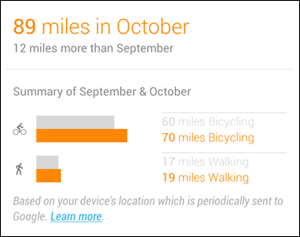Google Now Becomes a Fitbit Competitor By Tracking Exercise
Google Now, a kind of reverse search engine for Android phones that offers useful information when it thinks you might need it, got an upgrade last week that quietly enabled it to track when a person is walking or cycling. Once a month, a notification offers a summary of those activities to give the user a sense of how much exercise they got.

Google’s official blog post announced other upgrades made at the same time, such as offering a user their boarding pass when they reach the airport, but omitted to mention the new activity tracking feature.
This feature brings Google Now into competition with Fitbit and other activity tracking devices. Although Google’s once-a-month summary isn’t as rich as the interactive records that Fitbit can provide, the search company’s app can at least tell the difference between walking and cycling, which Fitbit and many similar devices can’t.
The addition is also hint that Google may be interested in developing its product into something that serves more than just the “Now” in its name. Most of the current features such as weather and offering information about traffic on your commute home serve immediate needs for information, but tracking physical activity over a month serves a more reflective urge. The former makes sense for a person in what Google engineers dub “lean forward” mode, when they’re actively looking for something. Pursing a summary of past activity is more for a “lean back” moment, when a person is seeking relaxation or focused on thinking rather than doing.
One of the most interesting things about Google Now is the way it demonstrates what the company can do when it pulls together the disparate threads of information is has on its users, for example combining what it knows about your inbox with your location to summon a boarding pass when you get to the airport. Combining data like that also holds a lot of potential for offering “life-logging” features to help people understand what they have been doing and what shapes their life—perhaps the activity-tracking feature is just the first step.
Keep Reading
Most Popular
Large language models can do jaw-dropping things. But nobody knows exactly why.
And that's a problem. Figuring it out is one of the biggest scientific puzzles of our time and a crucial step towards controlling more powerful future models.
The problem with plug-in hybrids? Their drivers.
Plug-in hybrids are often sold as a transition to EVs, but new data from Europe shows we’re still underestimating the emissions they produce.
Google DeepMind’s new generative model makes Super Mario–like games from scratch
Genie learns how to control games by watching hours and hours of video. It could help train next-gen robots too.
How scientists traced a mysterious covid case back to six toilets
When wastewater surveillance turns into a hunt for a single infected individual, the ethics get tricky.
Stay connected
Get the latest updates from
MIT Technology Review
Discover special offers, top stories, upcoming events, and more.